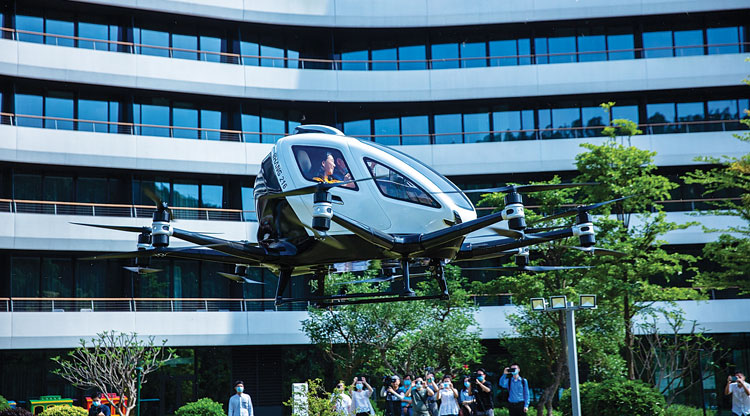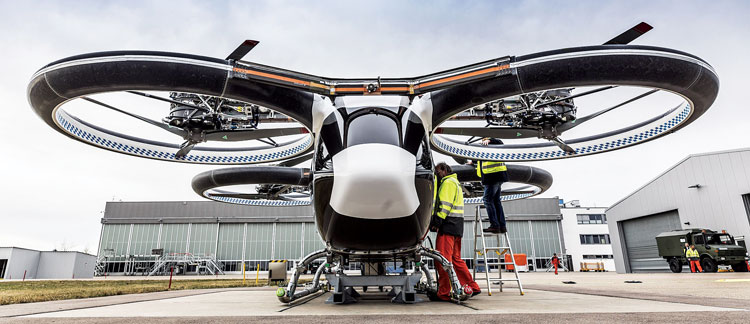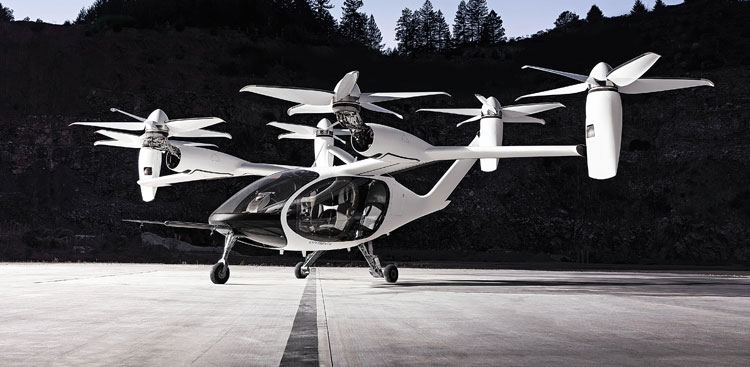INDIAN ARMED FORCES CHIEFS ON
OUR RELENTLESS AND FOCUSED PUBLISHING EFFORTS

SP Guide Publications puts forth a well compiled articulation of issues, pursuits and accomplishments of the Indian Army, over the years

I am confident that SP Guide Publications would continue to inform, inspire and influence.

My compliments to SP Guide Publications for informative and credible reportage on contemporary aerospace issues over the past six decades.
VTOLS which can be a Reality in Future
Almost all aviation major companies are investing heavily and collaborating in meaningful Research and Development of vehicles capable of Vertical Takeoff and Landing, facilitating Urban Air Mobility (UAM)

 | The author is a Wing Commander posted to Indian Air Force Headquarters in New Delhi. He has 17 years of aviation experience and more than 3000 flying hours. He is alumnus of National Defence Academy and has done his MBA in International Trade Management and MA in Human Resource Management. Currently he is pursuing his PhD in Aviation Management. |
By 2050, the global population is projected to grow by over 2 billion to nearly 10 billion, with almost 70 per cent of us living in an urban environment. Urban traffic congestion is likely to get worse in the metro cities around the world. For over eight decades, sci-fi writers and visionaries have discussed the idea of “Flying Cars”, which will be able to get us from our rooftops or gardens to any place we wish to travel, avoiding the traffic on road. Today we are already at the end of second decade of 21st century, and we have seen most of other sci-fi imaginations like video calls, sleek mobile phones, robots, cloning and artificial intelligence become a reality. The idea of flying from the house to office is limited to very few super rich who can afford helicopters. Helicopters’ capability of Vertical Takeoff and Landing (VTOL) has made them an integral part of the military forces and a fancy toy for the billionaires.
eVTOLs are light commercial aircraft that can take off and land vertically like helicopters and fly forward like airplanes
The helicopters have not been able to find many takers in air taxi segment because they are costly, noisy, maintenance intensive and potentially dangerous machines. A new class of flying vehicle in this VTOL segment which could overcome these issues has been a dream of both - the Car makers as well as the aircraft manufacturers. These are being called Electric Vertical Take-off and Landing (eVTOL) vehicles. eVTOLs are light commercial aircraft that can take off and land vertically like helicopters and fly forward like airplanes. Unlike helicopters, they use batteries instead of Aviation Turbine Fuel for propulsion and are more maneuverable, less complex, and more efficient than helicopters. They are designed to fly at a lower altitude than commercial aircraft and will be either piloted or autonomous. The advancements in technology both hardware and software is making this possible. The progress in weight reduction, carbon fiber composites, denser and higher energy density batteries which improve the power to weight, Smaller, lighter electric motors, more powerful micro motors for distributed electronic propulsion are the reasons for this advancement.

Almost all aviation major companies are investing heavily and collaborating in meaningful Research and Development of such vehicles. Uber has collaborated with AT & T, Joby Aviation and Hyundai; Toyota is also investing in Joby Aviation, Boeing has collaborated with Kitty Hawk and Porsche; and German company Volocopter has collaborated with London based startup Skyports. The US Air Force has officially started its search for a “flying car” able to speedily shuttle troops and equipment into war zones, when it released a solicitation this year. As per their program named “Agility Prime”, USAF is interested in Electric Vertical Take Off and Landing (eVTOL) that could incorporate electric or hybrid propulsion and be controlled by an onboard pilot, a remote pilot or be totally autonomous. Most of these R&D projects are focusing on two propulsion system alternatives, which differ dramatically from traditional helicopters. NASA is also working towards a safe and efficient air transportation system where everything from small package delivery drones to passenger-carrying air taxis can operate above populated areas. Initially they called it Urban Air Mobility (UAM) but now they are referring to it as Advanced Air Mobility (AAV).

CHARACTERISTICS
LILIUM JET
| Country | Germany |
| Manufacturer | Lilium GmbH |
| Crew | None (Fully automated) |
| Passenger | Five |
| Empty Weight | 440 Kg |
| Max Take-off Weight | 640 Kg |
| Powerplant | 36 × Vertical Electric 320 kW total installed power |
| Max Speed | 300 km/h |
| Cruise speed | 300 km/h |
| Range | 300 km |
VOLOCOPTER 2X
| Country | Germany |
| Manufacturer | Volocopter GmbH |
| Crew | One |
| Passenger | One |
| Empty Weight | 290 kg |
| Max Take-off Weight | 450 kg |
| Powerplant | 18 × three-phase PM synchronous brushless DC electric motors |
| Max Speed | 100 km/h |
| Cruise speed | Similar to max speed |
| Range | 27 km |
EHANG 216
| Country | China |
| Manufacturer | EHang |
| Crew | None (self-piloted) |
| Passenger | Two |
| Max Take-off Weight | 815 kg |
| Powerplant 16 | 16-bladed |
| Max Speed | 130 km/h |
| Cruise speed | 130 km/h |
| Range | 16 km (21 Mins) |
AIRBUS CITYAIRBUS
| Country | Multinational Project |
| Manufacturer | Airbus |
| Crew | One (Optional) |
| Passenger | Four |
| Max Take-off Weight | 2200 kg |
| Powerplant | 8 × vertical electric ducted fan, 100 kW (130 hp) each specially designed Siemens SP200D direct-drive, 4 × 140 kW (190 hp) battery output |
| Cruise speed | 120 km/h |
| Range | 15 Mins |
JOBY AVIATION S4
| Country | USA |
| Manufacturer | Joby Aviation (Collaboration with Uber) |
| Crew | One (Optional) |
| Passenger | Four |
| Max Take-off Weight | 1,815 kg |
| Powerplant | 6 high performance electric motors, Lithium-nickel-cobalt-manganese-oxide batteries |
| Max Speed | 322 km/h |
| Cruise speed | Similar to Max speed |
| Range | 241.4 km |
source: wikipedia, https://evtol.news
MULTIROTOR/ MULTICOPTER
These are wingless aircraft with multiple rotor assemblies. This design makes it low noise and hover efficient. The main disadvantage of this design is their poor cruise efficiency. They have low cruise speeds (90 – 100 kmph) and ranges of upto 50 km. Compared to helicopters they are cheaper, noise free and environment friendly. They will be useful for short distance travel.
TILT ROTOR/ TILT JET
These machines get airborne like helicopters and thereafter the rotors/ propellers tilt their angles and fly like fixed wing aircraft. Generally these vectoredthrust eVTOLs have multiple propellers or jet engines which can be transformed by tilting, from vertical to horizontal flight. These can reach speeds of up to 300 km/h and have an approximate range of 300 km. This technology is very complex and all the actuators that tilt the engines need to be fully redundant and certified for multiple failures. This redundancy leads to additional weight and cost and it also requires more time for certification.
As per Vertical Flight Society There are around 300 designs that are at different stages of production today. It is a very difficult task to pick up the five most significant eVTOLs at this stage because none of the vehicles are yet certified and their performances are still not established but based on the available information and discussion with the experts in the field, these five vehicles appear to have a great future.
Almost all aviation major companies are investing heavily and collaborating in meaningful Research and Development of such vehicles
- LILIUM JET: The Lilium Jet is one of the leading machines for urban air mobility by 2025. As per current regulations initially pilots will be needed till the time regulations permit fully autonomous flights. Lilium is growing very fast as a company due to growing interest of investors. Although it’s just a 500 employee company as of now, it has already got investment worth between $750 million and $1 billion from it’s investors Tencent, Atomico, Freigeist and LGT.
- VOLOCOPTER 2X: The capabilities of the machine itself is very limited but Volocopter is very ambitious with it’s designs. It’s range is currently very less but it has already made itself visible in various Air Shows. They have been able to attract customers by addressing their concerns. They have a ballistic parachute stowed on top in case something goes wrong. This model is likely to be part of Dubai’s Flying Taxi fleet. The aircraft entered serial production in April 2018.
- EHANG 216: EHang became a publicly listed company on the Nasdaq Global Market on December 12th, 2019. It received the first special flight authorisation from the Federal Aviation Administration (FAA) and conducted its firstever trial flight of EHang 216 in America on January 8, 2020. Although the performance of this vehicle is very limited but they are trying to pitch themselves for various roles like sight-seeing, fire fighting etc and they might be able to rule this niche market.
- AIRBUS CityAirbus: CityAirbus is a multirotor intended to carry four passengers, with a pilot initially and to become self-piloted when regulations allow. The company has got vast experience in Urban Air Mobility due to their other efforts like Vahana. They demonstrated their first flight but the reason to consider them a vehicle for future is the expertise that Airbus holds and their previous projects have added lots of learning value for future projects.
- JOBY AVIATION S4: The S4 completed a piloted test flight that included a vertical takeoff, 15 minutes of flight along a 15 mile (24.1 km) in early 2017. Uber has signed a multi-year commercial partnership with Joby Aviation to launch a fast, reliable, clean and affordable urban air taxi service in select markets. Joby Aviation has been relatively secret with its S4 aircraft. It is believed to be a continuation of the Joby S2 design. At the 2019 Vertical Flight Society’s sixth annual eVTOL Symposium Joby revealed additional information and initial performance details of test flights of scale and full-sized demonstrators. Dallas, Los Angeles and Dubai are likely to be the first cities where the initial trials for Urban air Mobility in collaboration with Uber will take place.

The future of Urban Air Mobility seems very bright with these eVTOL machines. There are many more players like Kitty Hawk, Sure fly and Pal-V which are also phenomenal and are at different stages of production and are likely to be seen in the skies at the same time. As per Morgan Stanley study the market for urban air mobility is expected to reach $1.5 trillion by 2040. These machines will prove to be game changers in roles like Air Ambulance, Search and Rescue, Civil Defence, Fire Fighting and of course Humanitarian Assistance and Disaster Relief (HADR). However there is still a lot to be done in terms of certifications of these machines, infrastructure for UAM and the regulations which will govern them. The Economy of operation, Payload, Range and Safety are going to be main driving factors in success of these machines.





